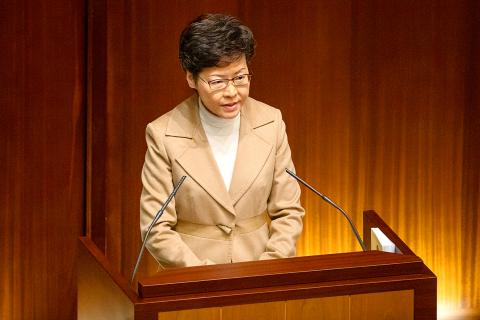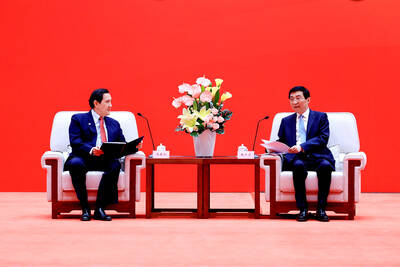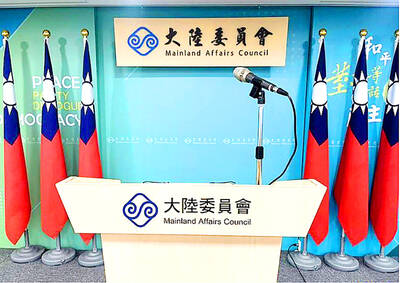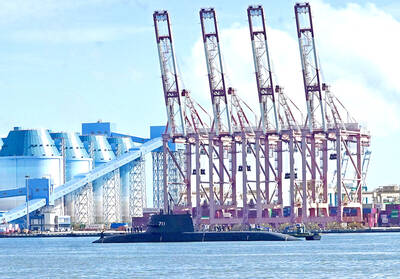The “one country, two systems” framework under which Hong Kong enjoys freedoms unknown in China could continue after a 2047 deadline if loyalty to Beijing is upheld, Hong Kong Chief Executive Carrie Lam (林鄭月娥) said yesterday.
Lam’s comments at the Hong Kong Legislative Council appeared to be an appeal to those who see Beijing as tightening its control over the semi-autonomous territory’s civic, economic and political life.
Hong Kong has been wracked by often violent anti-government protests since June last year, although they have diminished considerably in scale following a landslide win by opposition candidates in elections for district councilors late last year.

Photo: Bloomberg
Hong Kong was handed over from British to Chinese rule in 1997 with a promise that it would maintain its own capitalist economy and Western-style institutions for 50 years.
“Only if we insist on implementing the ‘one country, two systems’ principle and practice it continuously and fully ... then I think there will be enough grounds for ‘one country, two systems’ to move ahead smoothly and there would be no change after 2047,” Lam said. “We have to uphold the principle of ‘one country.’ Only by doing this, can ‘one country, two systems’ be moving forward smoothly.”
Lam’s comments echoed language from Chinese Communist Party leaders, who have said that Hong Kong’s unique system is predicated on respect for Chinese sovereignty over the territory.
Beijing routinely accuses political opponents in Hong Kong of seeking to split the territory from China with the backing of foreign forces.
While it was not clear whether Lam was speaking in her own right, or under order or in coordination with Beijing, her comments had the feeling of a final warning to the people of Hong Kong that they “need to wear their loyalty to Beijing on their sleeves ... or else,” said Steve Tsang (曾銳生), director of the China Institute at London’s School of Oriental and African Studies.
Tsang pointed to the appointment of hardliner Luo Huining (駱惠寧) as China’s top representative in Hong Kong as an indication of Chinese President Xi Jinping’s (習近平) determination to end the protests.
In that context, Lam’s statement might have been a last-ditch appeal to the opposition in hopes of avoiding more serious consequences, although it is unlikely to have the desired effect, he said.
“I would be very surprised if Lam’s warning would be heeded in Hong Kong,” Tsang said. “Instead, it may well get the hardcore of the protesters annoyed.”
Lam also said that she hoped to announce next month the formation of an independent review committee to look into the root causes of the unrest.
Academics, experts and social leaders have been recruited for the committee, although some are reportedly reluctant to join out of fear of personal attacks or online harassment if their personal information is leaked by opponents.

CHIP WAR: The new restrictions are expected to cut off China’s access to Taiwan’s technologies, materials and equipment essential to building AI semiconductors Taiwan has blacklisted Huawei Technologies Co (華為) and Semiconductor Manufacturing International Corp (SMIC, 中芯), dealing another major blow to the two companies spearheading China’s efforts to develop cutting-edge artificial intelligence (AI) chip technologies. The Ministry of Economic Affairs’ International Trade Administration has included Huawei, SMIC and several of their subsidiaries in an update of its so-called strategic high-tech commodities entity list, the latest version on its Web site showed on Saturday. It did not publicly announce the change. Other entities on the list include organizations such as the Taliban and al-Qaeda, as well as companies in China, Iran and elsewhere. Local companies need

CRITICISM: It is generally accepted that the Straits Forum is a CCP ‘united front’ platform, and anyone attending should maintain Taiwan’s dignity, the council said The Mainland Affairs Council (MAC) yesterday said it deeply regrets that former president Ma Ying-jeou (馬英九) echoed the Chinese Communist Party’s (CCP) “one China” principle and “united front” tactics by telling the Straits Forum that Taiwanese yearn for both sides of the Taiwan Strait to move toward “peace” and “integration.” The 17th annual Straits Forum yesterday opened in Xiamen, China, and while the Chinese Nationalist Party’s (KMT) local government heads were absent for the first time in 17 years, Ma attended the forum as “former KMT chairperson” and met with Chinese People’s Political Consultative Conference Chairman Wang Huning (王滬寧). Wang

CROSS-STRAIT: The MAC said it barred the Chinese officials from attending an event, because they failed to provide guarantees that Taiwan would be treated with respect The Mainland Affairs Council (MAC) on Friday night defended its decision to bar Chinese officials and tourism representatives from attending a tourism event in Taipei next month, citing the unsafe conditions for Taiwanese in China. The Taipei International Summer Travel Expo, organized by the Taiwan Tourism Exchange Association, is to run from July 18 to 21. China’s Taiwan Affairs Office spokeswoman Zhu Fenglian (朱鳳蓮) on Friday said that representatives from China’s travel industry were excluded from the expo. The Democratic Progressive Party government is obstructing cross-strait tourism exchange in a vain attempt to ignore the mainstream support for peaceful development

DEFENSE: The US would assist Taiwan in developing a new command and control system, and it would be based on the US-made Link-22, a senior official said The Ministry of National Defense is to propose a special budget to replace the military’s currently fielded command and control system, bolster defensive resilience and acquire more attack drones, a senior defense official said yesterday. The budget would be presented to the legislature in August, the source said on condition of anonymity. Taiwan’s decade-old Syun An (迅安, “Swift Security”) command and control system is a derivative of Lockheed Martin’s Link-16 developed under Washington’s auspices, they said. The Syun An system is difficult to operate, increasingly obsolete and has unresolved problems related to integrating disparate tactical data across the three branches of the military,